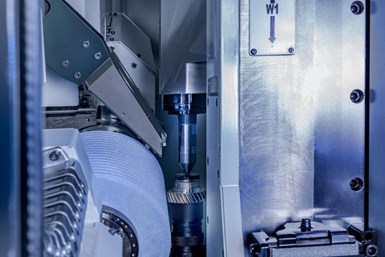Emag Grinding Solutions Provide Precise Gear-Profile Grinding
The G 160 and G 250 gear-profile grinding machines provide short chip-to-chip times, intelligent axis concepts as well as thermal and mechanical stability.
Emag SU’s gear-profile grinding solutions include the G 160 and the G 250 machines.
The G 160 is used for components up to module three and with a maximum OD of 160 mm. It features two parallel workpiece tables that move alternately at high speeds. While one component is machined, the internal loading robot inserts a blank into the other spindle or unloads the finished component beforehand. The G 160 does not have a tangential axis; instead, the existing Y- and Z-axes generate a “virtual” tangential axis through simultaneous movement. As a result, the distance between the A-axis and the tool-contact point is very small, which prevents the so-called “ghost frequencies” on the surface of the component.
The larger G 250 machine features precision, minimum chip-to-chip times, short setup times and reliability for components with a maximum length of 550 mm. The machine also has a double table (like the G 160). Loading and unloading operations, as well as component measurements, are performed in concurrently with cycle times. Additionally, the grinding mandrel can accommodate grinding wheels with different diameters, and the entire design is very rigid. Gear-generating grinding and profile grinding take place on the main grinding spindle, so the machine does not have a thermal growth. It can also be retooled for the other process in just a few minutes.
Additionally, Emag’s new “Sky Grind” process enables the final grinding on the gear to be carried out completely dry. This is made possible by a dual-tool system with two different tool spindles in the machine: one for finish machining by hobbing and one for finish machining by grinding. According to the company, while cycle times of conventional wet gear grinding and the Sky Grind process are very similar, the cost and overall energy consumption is very different.
RELATED CONTENT
-
Studer S100 Grinding Machine For High-Precision, Flexible, Reliable Grinding
The machine is well suited for a wide range of internal, surface and external grinding applications, making it well suited for the entry-level market.
-
Cylindrical Grinder Shows Off High Precision
The United Grinding Studer S131r cylindrical ID-radius grinding machine targets tough ID grinding operations and a range of hard-to-machine materials.
-
RWK Creates Tools to Hold Tight Tolerances, Ensure Repeatability
PMTS 2023: The company grinds all of its tooling between centers which enables its tools to hold tight tolerances and is the most efficient method of ensuring repeatability in round tooling.




